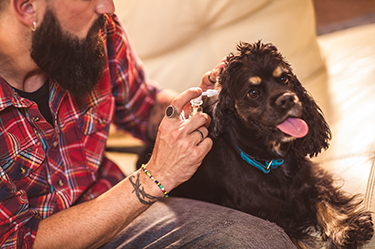Healthy ears in your dog and keeping them that way

Maintaining the overall health of your dog should include the routine inspection of their ears. For most dogs, their ears never present a concern but for certain breeds, especially those with allergic dermatitis like the Boxer, Shih Tzu and West Highland Terrier, those with drooping ears, such as spaniels, Irish Setters and Basset Hounds, and those who are lovers of water are prone to developing long term ear concerns. By maintaining a routine inspection of your pet’s ears you will be able to recognize a problem early and have your veterinarian diagnose and treat the condition before it escalates.
Allowing a simple case of excess wax build up or water in the ear canal, which can both be treated with over the counter ear cleaning solutions, to go unchecked can lead to ear infections, severe pain, balance problems, hematomas (the ear flap filling up with blood due to excessive head shaking) and even deafness.
In order to prevent these long term problems from occurring, a simple once a month inspection of your pet’s ear is in order. Gently lift your dog’s ear and look (and smell) inside. The inner ear flap and canal should be pink and clean. There shouldn’t be any discharge or redness, swelling or odor. If you notice any of these it’s time to call your veterinarian who can diagnose the situation before it leads to long term damage.
Cleaning your dog’s ears is a simple procedure, however there are a few things to avoid.
- Do NOT use alcohol, hydrogen peroxide or vinegar to clean your dog’s ear canal.These products will dry out the canal but they can also take it to the extreme, causing more problems in the process.There are veterinary products designed to clean the ear canal as well as those that dry the canal.There are even products which have ingredients to do both.Ask your veterinarian which she recommends.
- Do NOT use a cotton swab (Q-tip™) in your dog’s ear canal as these have a tendency to pack any built up wax, further into the canal, causing more damage and could even puncture the ear drum if inserted too far.
In order to clean the ear properly, follow these simple steps.
- Put on an apron or smock or clothing you don’t mind getting a little messy.You’ll understand why in a moment.
- Lift up the flap of the ear and add the appropriate cleaning solution.Be careful not to let the tip of the solution container to touch the ear or the ear canal, as this could contaminate the solution inside.Fill the canal until it is nearly overflowing.
- While holding the ear flap up, massage the base of the ear for 30 seconds.You will hear a “squishing” sound.That’s good.That is the sound of the solution loosening up any wax and debris in the canal.
- Allow your dog to shake his head.This is why you are wearing the apron/smock/old clothes.Letting him shake his head will allow the loosened wax and debris to work its way up and out of the canal
- Use absorbent gauze to wipe up the loosened debris from inside the ear.Don’t clean farther into the canal than you can put a finger and don’t use cotton or paper towels as these both can leave behind fibers leading to more irritation.
- Reward your dog with a treat and then repeat this with the other ear.
By performing routine inspection and cleaning of your dog’s ears you can prevent long term problems, but occasionally you may find there has been a change in the appearance of your dog’s ears. As soon as you notice any change in the color, any discharge or odor, contact your veterinarian for a detailed ear exam.
A few simple tests, such as a microscopic exam of the discharge will determine if your dog has ear mites or a yeast infection. An otoscope exam (a device to look into the ear canal) can show inflammation, excessive wax buildup that hasn’t been removed and even foreign objects or masses in the ear canal. Your veterinarian may also need to perform a tissue biopsy or even take an X-Ray depending on the initial exam.
By knowing what your dog’s ears “normally” look like you have a greater chance at catching changes in their appearance early enough to prevent long term damage. Besides routine inspection, for those breeds that require it, the simple monthly cleaning of the ear canal we detailed, is appropriate with the product recommended by your veterinarian. Following these steps will help your dog enjoy the quality of life you want and expect him to have.
Sources:
https://petswebmd.com/dogs/dogs-disharge/ear
https://vcahospitals.com/know-your-pet/instructions-for-ear-cleaning-in-dogs
https://www.akc.org/expert-advice/health/dog-ear-infections/
Careers
Are you looking for a place to let your talents shine? At Covetrus, we help our practitioner customers better serve their patients and take pride in providing the best customer experience possible. Search our open positions to see our available opportunities.
Newsletter
Stay current with what’s going on with Covetrus, subscribe to receive our newsletter and email communications. Subscribers will receive the latest information in practice management, sales and marketing, animal health, and more.


Leave a comment